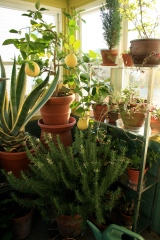Almost 10 years ago to the day I wrote about the little lopsided glassed-in entry porch that sold me on this house, and tentatively named it “the plantry.” I have filled it to the gills every fall since with tender plants and cuttings — and, of course, the name stuck.
Over the years Z improved it. He installed exterior doors that closed and an interior door with a view. He plumbed a spigot, hung a fan, and found a plug-in programmable thermostat that turns the space heater on automagically. And, over the last 10 years, he has wooed me with whispers about turning it into a “proper greenhouse.”
Other (less sexy) projects have taken precedence, such as replacing a furnace that coughed black smoke, putting a new roof on the rest of the house, reflooring the bathroom and kitchen, and installing a wood stove in the living room. (Super sexy, that one.) Being unhandy, I am the soul of patience — and gratitude. Obviously.
 This year the plantry roof, which we didn’t bother replacing back when the rest of the house was done, really started to look rough and Z got busy realizing my wildest greenhouse dreams. He started by cathedral-ing the ceiling, insulating the walls and spraying the interior bright white, all of which is a game changer light- and heat-wise. I contributed by thinning the herd of plants that needed to be moved in and out during the project, and by freeing up 2 more sets of IKEA metal shelves. (In library-speak, I “weeded” my gardening books. There’s probably another post in that.) The polycarbonate panels for the roof arrive at the end of the week — much later than originally anticipated and maybe too late to install before winter. That’s OK. The plantry is still and again my favorite room in the house, brighter and cozier than it ever was before. I’d be out there writing this right now if the living room stove wasn’t ablaze…
This year the plantry roof, which we didn’t bother replacing back when the rest of the house was done, really started to look rough and Z got busy realizing my wildest greenhouse dreams. He started by cathedral-ing the ceiling, insulating the walls and spraying the interior bright white, all of which is a game changer light- and heat-wise. I contributed by thinning the herd of plants that needed to be moved in and out during the project, and by freeing up 2 more sets of IKEA metal shelves. (In library-speak, I “weeded” my gardening books. There’s probably another post in that.) The polycarbonate panels for the roof arrive at the end of the week — much later than originally anticipated and maybe too late to install before winter. That’s OK. The plantry is still and again my favorite room in the house, brighter and cozier than it ever was before. I’d be out there writing this right now if the living room stove wasn’t ablaze…



 Last fall I repainted the room – from the bilious yellow to a bilious green and obnoxious teal. Stand back, Martha. (Some other day I will try again to match the lovely colors in my head.) This summer we bought a full glass paned kitchen door that lets the porch light in. When we buy the winning ticket, I’ll ask Z to enlarge the porch and convert it to a full greenhouse with working vents and drains in the floor. For now, I’d settle on replacing the outside doors. And until then I’ll probably just “winterize” them again with blow dryer plastic and draft dodgers.
Last fall I repainted the room – from the bilious yellow to a bilious green and obnoxious teal. Stand back, Martha. (Some other day I will try again to match the lovely colors in my head.) This summer we bought a full glass paned kitchen door that lets the porch light in. When we buy the winning ticket, I’ll ask Z to enlarge the porch and convert it to a full greenhouse with working vents and drains in the floor. For now, I’d settle on replacing the outside doors. And until then I’ll probably just “winterize” them again with blow dryer plastic and draft dodgers.